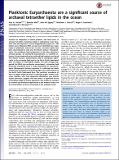Planktonic Euryarchaeota are a significant source of archaeal tetraether lipids in the ocean
Author(s)
Summons, Roger Everett; DeLong, Edward; Lincoln, Sara Ann; Wai, Brenner; Eppley, John Marmaduke; Church, Matthew J.; ... Show more Show less
DownloadLincoln-2014-Planktonic Euryarcha.pdf (765.8Kb)
PUBLISHER_POLICY
Publisher Policy
Article is made available in accordance with the publisher's policy and may be subject to US copyright law. Please refer to the publisher's site for terms of use.
Terms of use
Metadata
Show full item recordAbstract
Archaea are ubiquitous in marine plankton, and fossil forms of archaeal tetraether membrane lipids in sedimentary rocks document their participation in marine biogeochemical cycles for >100 million years. Ribosomal RNA surveys have identified four major clades of planktonic archaea but, to date, tetraether lipids have been characterized in only one, the Marine Group I Thaumarchaeota. The membrane lipid composition of the other planktonic archaeal groups—all uncultured Euryarchaeota—is currently unknown. Using integrated nucleic acid and lipid analyses, we found that Marine Group II Euryarchaeota (MG-II) contributed significantly to the tetraether lipid pool in the North Pacific Subtropical Gyre at shallow to intermediate depths. Our data strongly suggested that MG-II also synthesize crenarchaeol, a tetraether lipid previously considered to be a unique biomarker for Thaumarchaeota. Metagenomic datasets spanning 5 y indicated that depth stratification of planktonic archaeal groups was a stable feature in the North Pacific Subtropical Gyre. The consistent prevalence of MG-II at depths where the bulk of exported organic matter originates, together with their ubiquitous distribution over diverse oceanic provinces, suggests that this clade is a significant source of tetraether lipids to marine sediments. Our results are relevant to archaeal lipid biomarker applications in the modern oceans and the interpretation of these compounds in the geologic record.
Date issued
2014-06Department
Massachusetts Institute of Technology. Department of Biological Engineering; Massachusetts Institute of Technology. Department of Civil and Environmental Engineering; Massachusetts Institute of Technology. Department of Earth, Atmospheric, and Planetary SciencesJournal
Proceedings of the National Academy of Sciences of the United States of America
Publisher
National Academy of Sciences (U.S.)
Citation
Lincoln, Sara A., Brenner Wai, John M. Eppley, Matthew J. Church, Roger E. Summons, and Edward F. DeLong. “Planktonic Euryarchaeota Are a Significant Source of Archaeal Tetraether Lipids in the Ocean.” Proceedings of the National Academy of Sciences 111, no. 27 (June 19, 2014): 9858–9863.
Version: Final published version
ISSN
0027-8424
1091-6490